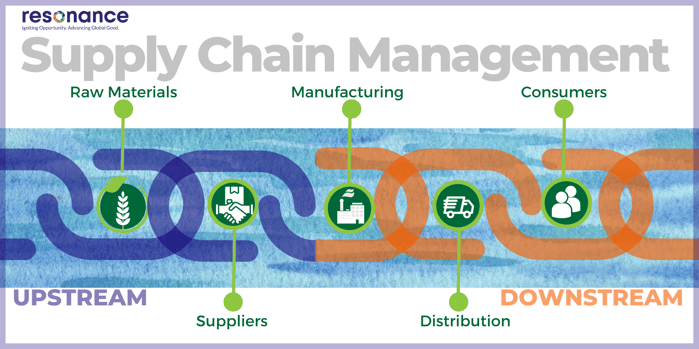One of our most followed Insights piece recently published is on the growing vocabulary of supply chain management, including its components, upstream, downstream, and extended, and emerging discussions around ethical supply chain considerations (i.e., “what is ethical?”).
Under our ongoing umbrella series, Research that Resonates, we feature a scholarly article of interest around the greater deliberations regarding Sustainable Supply Chain Management (SSCM) and ethical supply chains, with the introduction of the concept of social supply chain practices, or what we are coming to understand as the social pillar of sustainability, or the “S” in ESG.
Appearing in the journal, Sustainable Production and Consumption (Issue 32, April 20 2022), authors Vernando, Halili, Tseng, Tseng & Lim sought through their study to expand the ‘social sustainability framework’ to investigate the impact of sustainable social supply chain practices on firm social performance. Relying on methodologies used in similar studies on other firm practices and links to performance, the team created and employed an electronic survey and sent it to manufacturing firms registered with the Federation of Malaysian Manufacturers (FMM) 2021 directory.
A quantitative approach to analysis was applied to 114 data sets to determine whether, and the extent to which, sustainable practices in Design, Distribution, Procurement, and Production showed a positive correlation to social impact in six areas:
- Equity
- Ethics
- Health and Welfare
- Human Rights
- Philanthropy
- Safety
Unpacking Terms First: What is Sustainable Supply Chain Management (SSCM)?
Before we report on the results of this study, it seems appropriate to unpack the concept of social supply chain practices and add it to the growing definitions under the umbrella of supply chain management. Of course, much of this terminology has become rooted in professional vernacular at this point and is often referenced by acronyms among those engaged in the supply chain trenches.
For example, sustainable supply chain management, or SSCM, is most typically defined as involving the integration of environmentally and financially viable practices into the complete supply chain lifecycle – from product design and development – to material selection. In the time since it emerged as a concept, downstream of production (distribution and sales cycles) have also been considered as part of sustainable supply chain documentation, particularly as more companies are pressed to factor in the sustainability of their finished products long after they leave the plant as part of ESG.
One of the most widely read research articles related to SSCM is a comprehensive literature review published by Seuring and Müller (2008), in Journal of Cleaner Production, who defined SSCM as “managing flows of information, material and capital through collaboration among supply chain networks while taking into account three dimensions of sustainable development (economic, social, & environmental).” In their conception and extensive literature review, SSCM approaches are associated with eco-oriented design, remanufacturing, inventory planning, and systems.
We raise attention to this article despite its publication date 15 years ago, because in many ways, the authors’ approach to summarizing research in the field to date at that time resulted in a conceptual framework that saw SSCM as having two distinct strategies applicable still:
- supplier management for risks and performance, and
- supply chain management for sustainable products. In addition, the authors noted that the research was dominated by “green/environmental issues,” and that “social aspects and the integration of the three dimensions of sustainability” was a rare focus.
According to Alghababsheh (2022), this reality rests on three factors gleaned from research:
- The fact that often social issues of supply chains have been perceived to have been less important compared to economic and environmental issues due to the relatively narrow range of their impact (Alghababsheh et al., 2020);
- A presumption that findings related to the environmental dimension are equally applicable to the social dimension (Huq and Stevenson, 2020); and finally,
- The lack of agreement on social issues in supply chains, partly due to their nature and fragmented evolution, has also impeded progress for scholars toward building and testing theory of social sustainability in SCM (Ahi and Searcy, 2015; Hutchins and Sutherland, 2008), which has made it especially difficult to explore the relationship between social sustainability in the supply chain and performance.
Sustainability leaders we work with from major companies have conveyed that this same tendency (and reasoning) is very much the case in practice, suggesting that the “E” in ESG can often be easier to implement and metric (e.g., decreases in effluents (water); reductions in emissions at the pipe) compared with social indicators. Yet they note there is growing pressure to build a business case around (social) drivers of sustainability. This coincides with an emergence in the growth of research, like our featured article, in mirroring what is happening practically.
What are Social Supply Chain Practices?
There is without a doubt some nebulousness around the concept of social supply chain practices. In some research, it refers to practices of assessment and collaboration within the supply chain. This is a slightly different lens than linkages of practices to social/societal impact measures inherently part of sustainability. That may be why many studies use “socially sustainable supply management” or “socially SSCM” practices to describe what our featured article includes.
As we know, with increasing pressures (and in many markets, regulations) from investors, shareholders, consumers, employees, civil society groups, and the media – corporations are actively factoring in their responsibility to ensure the health, safety, and wellbeing of individuals along all phases of operations, including deep into their supply chains, as part of what many dub Corporate Social Responsibility (CSR).
SSCM practices are inherently part of this responsibility and are intended to help create, protect, grow, and drive long-term environmental, social, and economic value for stakeholders along a company’s value chain, integrated as part of good governance into the lifecycles of goods and services.
The “S” (or social), can include an array of considerations, including the six outlined categories in our featured article as part of the authors’ use of an adapted ‘social sustainability framework (recalling from above): Equity, Ethics, Health and Welfare, Human Rights, Philanthropy, and Safety.
In terms of practices that seek to address the “social” sustainability issues in supply chains, they are many, often diverse, often specific to the company, often involve partnerships to design and implement, and often have varied outcomes that are contextually dependent. According to Alghababsheh (2022) these widely varied practices typically fall into four approach categories” (1) internal approaches (e.g. internal adaptation); hands-off approaches (e.g. supplier switching); hands-on approach (e.g. collaboration practices and partnerships); and relational approaches (e.g. justice).
Findings of our Featured 'Research that Resonates'
We have attempted to briefly foreground our featured article with some conceptual unpacking, albeit brief; thus, we encourage those interested in more depth to review the article with more attentiveness to examine the ways in which the authors delineate and describe the 6 SSCM factors considered in their study, as well as in-depth discussion of their findings.
To summarize here, the study found that there were several SSCM practices that correlated with firm performance across social concerns and indicators. As a result, the authors argue that a ‘social sustainability framework’ can support firms in their SDGs initiatives to improve community health and well-being, reduce inequality and lead to responsible production and consumption.
Specifically, the study found a positive path from sustainable design to firm social performance, with a positive correlation between sustainable design and equity, ethics, human rights, and safety, implying that manufacturers should consider designing goods that will not harm current and future generations.
The authors also found that distribution strategies and sustainable production strategies could improve the firm’s social performance across some, but not all, of the categorical impacts. A focus on health & welfare, philanthropy and safety in distribution strategies was linked to greater social performance; a focus on all social categories except equity and ethics as part of production practices was found to improve a firm’s overall social performance.
Procurement Still an Area of Challenge in Terms of Materiality and the "S"
What was concerning (but nont surprising) given our own understanding of sustainability leader challenges in practice, was the study found no evidence of the impact of sustainable procurement on firm social performance. That’s not to say they found that reported sustainability practices that focused on social challenges as part of procurement were not linked to improved social performance; rather, the authors found that ethics, health, welfare, human rights, philanthropy, and safety were all immaterial to firms when sourcing materials.
The authors do note two possibilities for this finding: (1) the integration of social practices as part of procurement is still a new consideration; and, relatedly, (2) procurement practices typically (particularly in developing countries) focus on procuring at the lowest cost (which may be why a social focus is still new).
These findings are not at all contrary to what sustainability leaders are reporting. Often the barriers to the operationalization of sustainability goals and approaches at the procurement level have everything to do with competing objectives: how DO companies integrate social goals as mainstream practice in procurement if doing so raises the cost of procuring inputs?
The authors note their findings show that sustainable design, distribution, and production impact a firm's social performance, and thus suggest manufacturing firms should support or prioritize these socially responsible or SSCM practices in these three facets in their operations to attain goals and improve competitive advantage. Yet the question of practices aimed at integrating the “S” in procurement, and how to build a business case and thus long-term materiality, continues to remain a challenge and focus of our clients as well, particularly those with heavy agricultural supply chains, driving much of our current and anticipated supply chain strategy, cross-sector partnership, design & innovation, and sustainable impact work.



